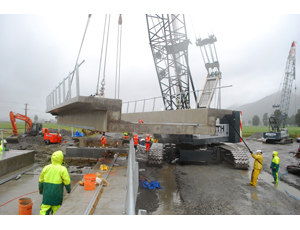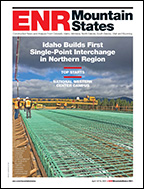

A 5.6-magnitude earthquake on January 5 gave South Island New Zealanders a sharp reminder of the devastating quakes which damaged much of Christchurch in 2010 and 2011. It also brought much of the rail network to a temporarily standstill while engineers checked the system’s safety.
KiwiRail, New Zealand's rail operator, declared Christchurch's North Line, South Line and Hokitika Line, clear to reopen after inspections. No serious issues were reported, says Ron Murray, KiwiRail spokesman for operations.
But the largely benign earthquake some 44 km (30 miles) south of Hokitika highlighted the importance of recent and extensive reconstruction works to upgrade the network.
The 2010 and 2011 earthquakes, along with a number of other significant quakes in recent years in the South Island as well as the Wellington region prompted KiwiRail to assess its portfolio of buildings across New Zealand and to make improvements as needed.
Work on the North Island so far has included the Wellington Metro Upgrade Project (WMUP) which over the next eight years will deliver significant improvements to the network's aging overhead traction systems and signalling. Years of inadequate investment have left the system under-maintainted, says Murray.
“Under-investment in New Zealand’s rail system is a well-recognised fact and since 2004 KiwiRail has been increasing the investment in the upgrade of its infrastructure,” explains Murray. For bridges, the annual budget has increased from some NZ$10m (US$7.5m) a year in 2004 to NZ$40m (US$30m) in 2010 and has remained at around that level since. Currently, KiwiRail operates on around 3,940 km (2,448 miles) of track which includes a total of 1,489 bridges, serving 189 mainline locomotives and around 4,740 freight wagons.
The recently completed Wellington Region Rail Programme (WRRP) prepares lines for the introduction of the new Matangi trains. The work included double tracking to Waikanae, constructing a third track into Wellington Station and improving the traction overhead to carry more power. Benefits include increased train speed, improved timekeeping for trains, a reduction in the number of random faults the provision of more train services to cope with growing demand. The WMUP will build on this and contribute to better network operability.
Major infrastructure work is also under way on the South Island. Timber-decked bridges, most of them over 100 years old, are being replaced in a rolling program. Among them are those between Lyttelton and Christchurch, which carried the first suburban electric rail in the country.
“This timber elimination program could definitely be described as a ‘rolling program’ in the sense that it is ongoing and will continue for another 25 to 30 years," says Murray. "There are some 500 bridges containing timber piers and timber spans, and it will take a long time to replace all of the timber structures.”
“The bridges are not being replaced in a sequential fashion. rather, they are being prioritised using a combination of risk assessment taking into consideration their individual condition and strategic importance of the various line segments,” he says.



Post a comment to this article
Report Abusive Comment